
Bug Fables: The Everlasting Sapling Review
I picked a weird time to play Bug Fables: The Everlasting Sapling. Paper Mario: The Origami King, hadn't been revealed yet, and I had wanted to play something to fill a void that had remained empty since 2004's Paper Mario: The Thousand-Year Door. You see, it's almost impossible to talk about Bug Fables without also talking about Paper Mario.
Moonsprout Games has openly and proudly worn the inspiration for their debut title on their sleeves and has pretty much directly courted players just like me, those who grew up and loved Paper Mario and The Thousand-Year Door, to revisit the sort of game that left us so enamored when we were younger. The cynic in me went into Bug Fables with a slight sense of apprehension, open to the possibility that this love letter might come off as a cheap imitation at best or a cringe-worthy counterfeit at worst. Instead, I found a charming, well-made, intelligent, and heartfelt game that exceeded my every expectation in nearly every way.

Back when it released two decades ago in 2000, Paper Mario was inexplicably (at the time) two distinct things: it was a paper-themed adventure starring Nintendo's mustached mascot, obviously, but it was somehow also the biggest RPG that the red-capped plumber had starred in since 1996's aptly named Super Mario RPG. The series would hold onto this nigh-unexplainable duality for one more entry with the 2004 sequel, but since then would begin to strongly lean towards the papercraft theming component and away from the style of game that the first two entries so strongly put forth. Super Paper Mario and Paper Mario: Color Splash are arguably well-made games, sure, but they just didn't occupy the same space that the first two did.
Bug Fables borrows the presentation style of the series without overtly theming the game around papercraft. Instead, Moonsprout focused on telling an original story while adapting gameplay mechanics, storytelling sensibilities, and RPG-style equipment and progression, and the result could not have turned out better.
Bug Fables tells the stories of three protagonists, Vi, Kabbu, and Leif, as they journey as a trio of Explorers for the Ant Kingdom, whose queen is on a quest to obtain the Everlasting Sapling, an artifact said to grant eternal youth. Instead of trading off partner characters while moving from chapter to chapter, Bug Fables establishes the main trio early on, and then allows the storytelling from that point to naturally weave in and out between the main thrust of plot alongside character-driven episodes interspersed within. It ends up being incredibly effective at strongly establishing each party member's personality traits and characterization in a way that chapter-specific partners would have never really allowed for.
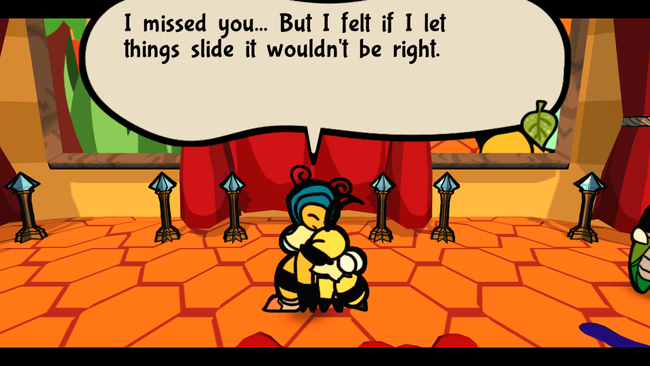
The main beat of the front-to-back storytelling is nothing ornate, putting forth a simple story with only a handful of small wrinkles, but it's still incredibly convincing at establishing a fun, believable world with an appropriate amount of intrigue and a surprising amount of background lore as well. Bug Fables doesn't really subvert any expectations, but it's also not really trying to. It does, however, manage to use simple, sometimes well-worn ideas in interesting and effective ways. Every character in the main trio has a few one-line character quirks, Leif is always hungry for instance, but Bug Fables uses the extended time spent with each member of the trio to really go further for each party member than I would have ever really expected.
For instance, Vi is an outcast of her homeland Bee Kingdom, daring to become an Explorer for the Ant Kingdom in an act of defiance against a society that values productive hard work over fulfillment of personal passions. She also has a nice personal story arc as well --- showing how she's fearful to ask her abandoned family for any sort of forgiveness because she's afraid that it would simply not be given. Kabbu and Leif also have tailored character arcs as well and all told, the degree that I could appreciate how the unlikely trio grew closer throughout the course of the game was fulfilling to watch evolve.
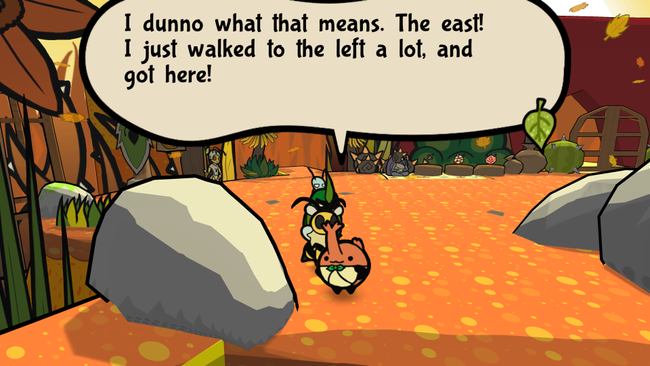
The moment-to-moment writing also benefits from the trio-protagonist setup. Instead of having one character act as the whole party's voice for any given scene, everyone is given equal time to interact with the world's inhabitants -- playing off of each other's personalities, chiming in with their own perspective on any given event, and even talking amongst each other frequently to relay their understanding of their current environment or situation. For instance, in any given location in the game, or in front of any given NPC, the whole trio can provide their input on the specific circumstance at the press of a button. Sometimes it's nothing more than a silly comment about a town's outlandishly dressed NPC, but oftentimes provides deeper context to the current story elements as well. This is a mechanic borrowed from Paper Mario's tattle system but improved upon wholesale.
As an aside, each of the three characters will have entirely unique dialogue for tattling every enemy in the game in battle -- an absurdly unnecessary level of detail that I love that Moonsprout went so far to implement anyway.
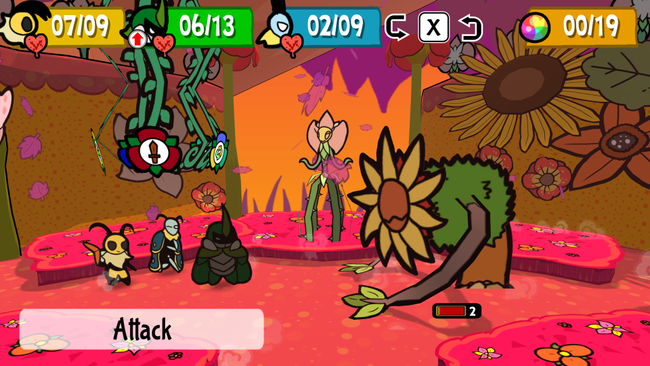
Speaking of NPCs, Bug Fables has a crazy amount of named characters to run into. Whether its the rival wasp Zasp, the veteran explorer Maki and his partner Kina, the traveling merchant duo Chicketly and Huscada, or the competing bee scientists HB and Honeycomb, the list goes on and on and on. There's never a shortage of interesting characters to interact with, each with unique designs and varying degree of either plot or gameplay involvement. Very rarely will you ever run into a nameless generic bug meant to simply fill the space of a town. It really helps to sell a sense of place for each location visited, rather than just having it all come across like a bug-themed amusement park.
As with everything else in Bug Fables, battles and exploration will also always involve the whole trio in play at any given time. Vi, Kabbu, and Leif will also have unique abilities to use both within the combat screen as well as when exploring the overworld. As with so many other things in Bug Fables, the general ideas behind combat might be borrowed, but the implementation is undeniably clever. Since all three party members are in play at once, the player instead gets a choice to decide the order they appear in battle. Whoever appears in front will get a boost to their damage, but are more likely to be attacked. Party members can even borrow turns from their allies at the cost of their second action being slightly less effective than their first. On top of that, certain Medals (think Paper Mario's Badges) will also affect different positions on the battlefield in different ways.
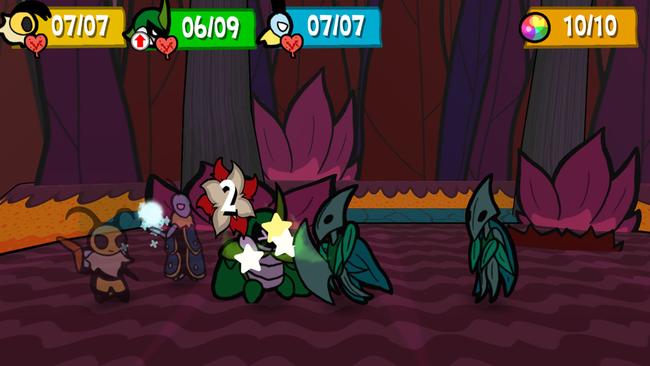
Vi, Kabbu, and Leif also have unique traits to their specific attack styles -- Vi and Leif can attack from a distance, while Kabbu is stuck only targeting the frontmost enemy for most of his abilities. Leif can target enemies burrowed underground while Kabbu can pierce defenses. Their abilities are also themed appropriately, with Leif primarily focused on buffing allies and inhibiting enemies, Kabbu focused on dealing and taking damage, and Vi as an all-around utility knife able to serve many roles depending on the player's preference or the requirement of the battle at hand.
I list these all out plainly because, at their core, each individual component of the battle system here is just a series of simple rules, but it all comes together so incredibly well. I constantly found myself switching the battle order, shifting turns around, and using different strategies in different engagements the suit the enemy I was facing. Bug Fables also allows players to toggle Hard Mode at any given time by simply equiping a specific Medal, which I would suggest for anyone with experience with this style of game.
In Hard Mode, I found myself well challenged and required to manage resources such as items, TP (think Paper Mario's FP), and Medal allotment effectively. Coming up with bespoke strategies to fight each chapter boss was incredibly rewarding to land on one that would overcome each obstacle, and beating specific bosses in Hard Mode rewards the player with unique new Medals as well for an extra in game incentive.
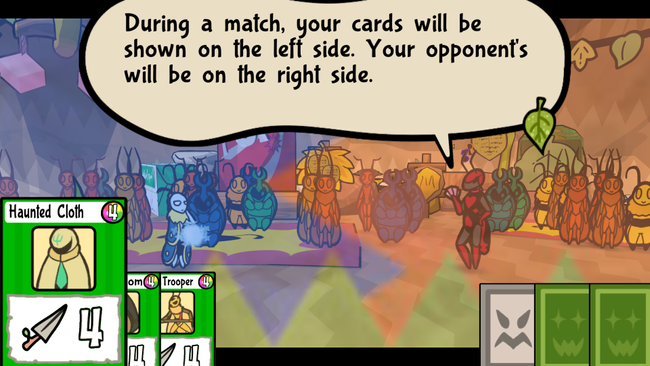
There's also an impressive amount of side content as well. Ranging from optional side quests to bounty bosses to mini-games like an arcadey dungeon crawler and even a collectible card game. Some of the quests simply involve a slight amount of backtracking to specific areas to battle a few enemies for a reward, but many are engaging little side-stories that help to flesh out each kingdom as you come across them. Several of the sidequests involve unique, challenging boss fights as well, some with cool rewards such as a piranha-plant style ally to assist in battle or access to unique shops with new badges or items.
Certain quests even strongly tie into the protagonists' backstories, rewarding with new abilities to use in the field or in battle. My only real criticism here is that anything that rewards in Berries, the currency of the game, ends up feeling lackluster due to how easy it is to cap out your wallet a good way through the adventure. But so many of the side objectives involve unique storylines or neat objectives or fun optional challenges that an uninspired berry reward is really more of a footnote than anything truly condemning.
One final note that I feel obligated to mention is that Bug Fables is accompanied by a wonderful soundtrack. I wasn't expecting to enjoy listening to some of the unique boss themes on repeat as often as I did. Several locations in the game each have striking musical accompaniments, such as the chapter 2 festival theme strongly contributing to the feel of the celebratory environment or the battle themes with the Wasp Kingdom soldiers being absolutely appropriate for their fights. If there's one single component of Bug Fables that's way better than it has any right to be, it's Tristan Alric's soundtrack.
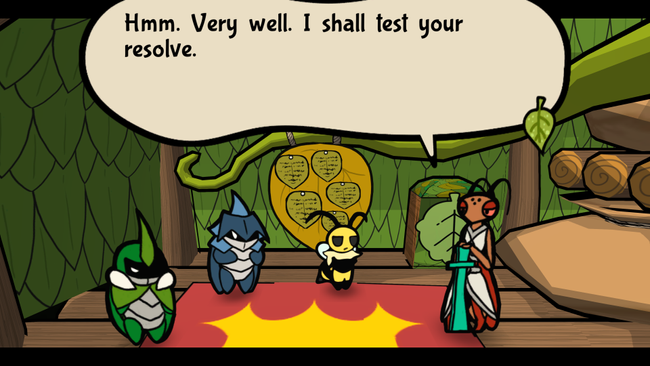
Despite not expecting it at all going in, Bug Fables: The Everlasting Sapling might just be my favorite game that I've played so far this year. It's the proper template for a love-letter done right -- to not simply staple oneself to the blueprint of their inspiration and meekly play parakeet, but to establish a cohesive identity beyond that. So many parts of Bug Fables felt so wholly inspired and creative that calling it a clone of anything else feels like a disservice. I wouldn't just suggest Paper Mario fans give Bug Fables a shot (though they absolutely should), but any fans of RPGs, period.
Bug Fables released on Steam in November 2019, and will release for consoles later this month.